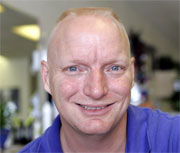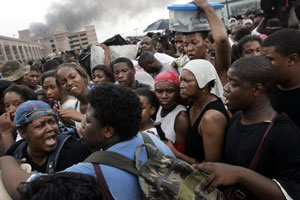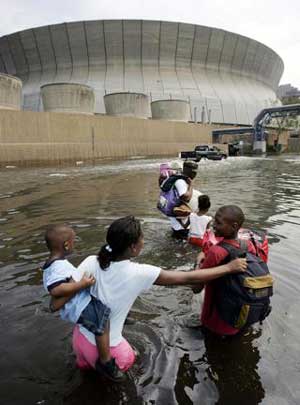 |
 | ||||||||||
Transmitting the Misery
|
 |
|||||||||
|
I got the call on Saturday around noon from one of the photo editors, Leslie White. She told me to get ready to fly to New Orleans for Hurricane Katrina. She promised me that she would not send me to any more hurricanes next year since I had already chased Dennis and Emily earlier in the year.
I packed quickly and got on the last Southwest flight leaving for New Orleans on Saturday night. I made two mistakes - not taking a satellite phone and not buying and packing some hip-waders.
That Sunday, I photographed people trying to enter the Superdome as well as people preparing for the storm. Of course there were the people (but just a few) getting drunk on Bourbon Street.
I stayed up most of the night in my 9th-floor room at the Astor Crowne Plaza Hotel at Bourbon and Canal Streets, napping as the winds got stronger.
I snuck out of the hotel around 6 a.m. and shot plywood being ripped off a storefront across the street. At that point I was told they were going to lock me out if I did not get in the hotel.
We finally secured a car and toured the city which was wind damaged. Reports were coming in of the levees breaking, that the city would be flooded. We took our initial photos of people being rescued from the rooftops of their homes. Not knowing the area, I had no idea the extent of the flooding and loss of life. The streets we drove down would soon be impassable. Monday passed into Tuesday and the horror was just beginning. Journalists who parked their cars in front of their hotels near the Superdome woke up to discover them under water. I had pulled my car out of the parking garage late Monday night and moved it to higher ground. One of the smarter things I did this trip.
I struggled to transmit photos. Cell phones signals were faint or overloaded with demand. I spent five hours trying to transmit photos until I was told that WWL, a Belo television station, had Ethernet available. With their help I has able to transmit the photos from the day.
The days start to blend together at this point. I photographed looting and evacuees, but my main goal was to try and get on a helicopter and photograph rescue efforts. Hancock and I waded into the Superdome and photographed Mayor Nagin, Governor Blanco and rescue personnel trying to come up with a plan for saving people's lives. I did get to fly on a helicopter that was flying to supply sandbags to protect the generator at the Superdome. It was my first sight of the massive flooding that had overtaken the city.
I went to the Superdome once the evacuation busses were starting to run and people were desperate to get out of the Dome, which had been their savior, but had turned into a hellhole.
I think the hardest part of the whole experience is being helpless. People came up to us and told their stories or asked us for current information. Where was the food and water? All I could tell them was to try to be patient because of the enormity of the catastrophe. It is hard to be patient when you see your relatives dying. I think most were just thankful to have someone - anyone - hear their story. I felt their hopelessness and can only hope that the images of their plight helped bring them some relief.
Some people say the media disrespects people, but people here wanted their stories told. With the exposure, people were able to let people know they were alive and well. It also gave them an opportunity to start fresh, with the help and support of the millions of people who read their story.
© Michael Ainsworth
Dispatches are brought to you by Canon. Send Canon a message of thanks. |
||||||||||
Back to September 2005 Contents
|
|



